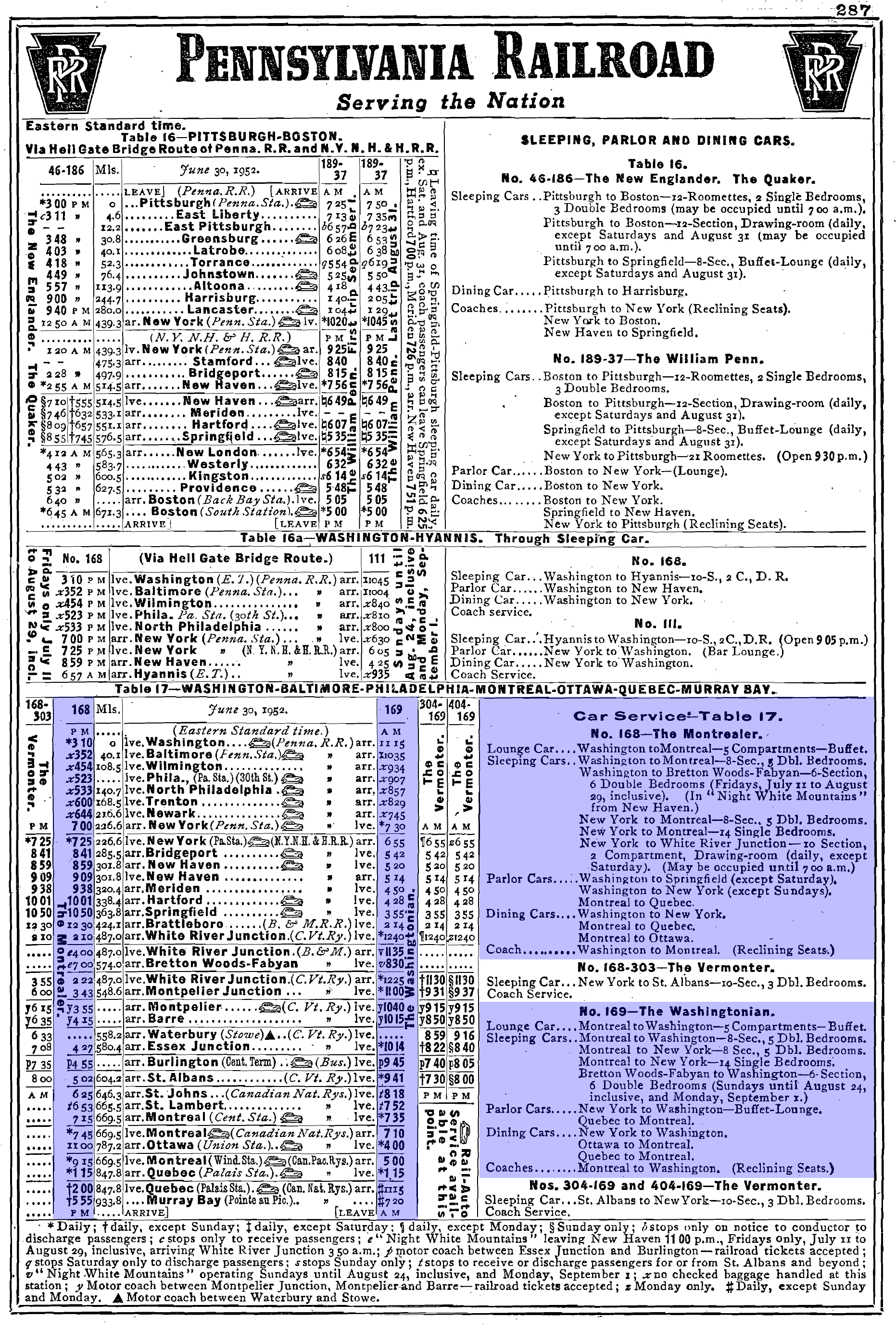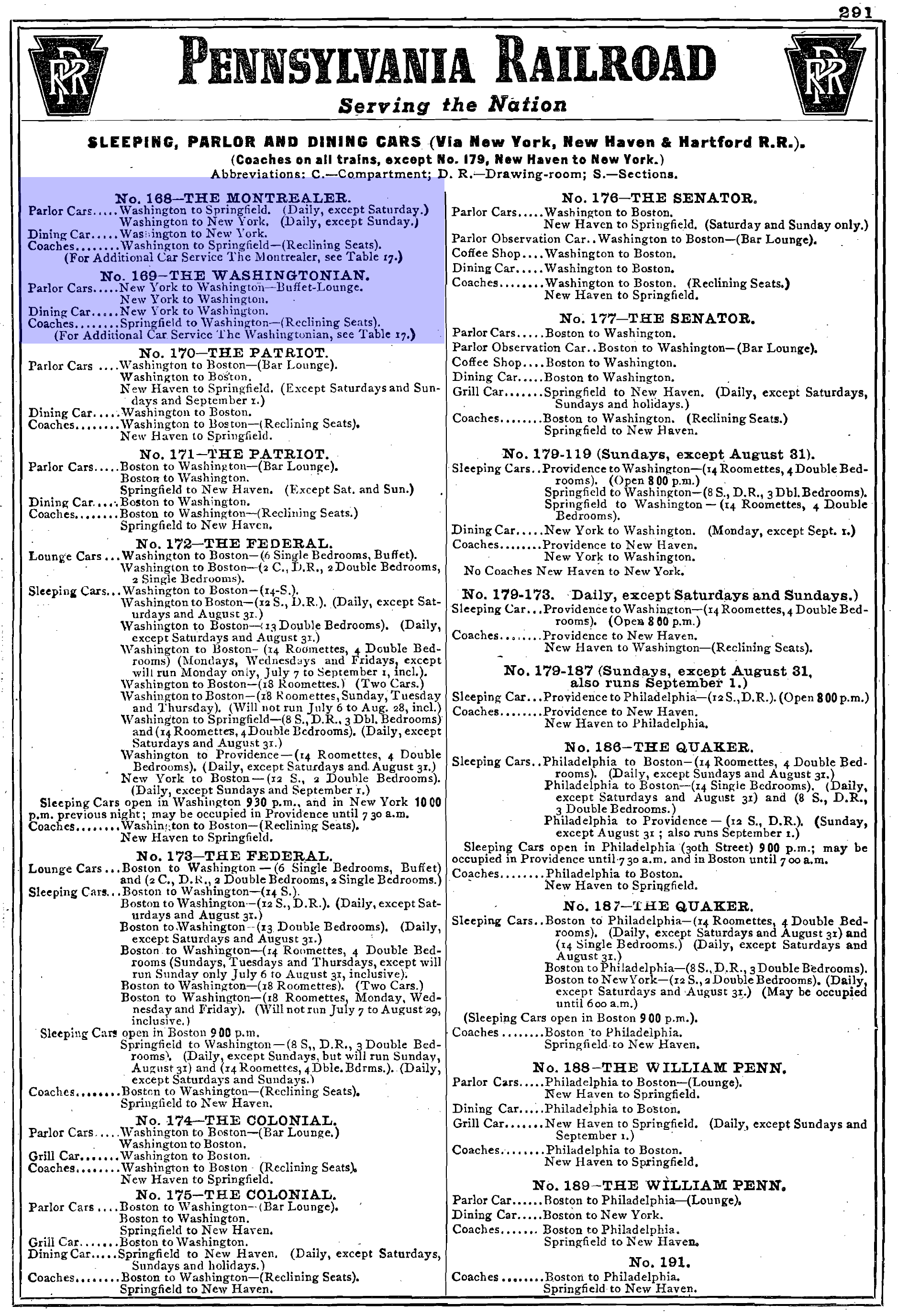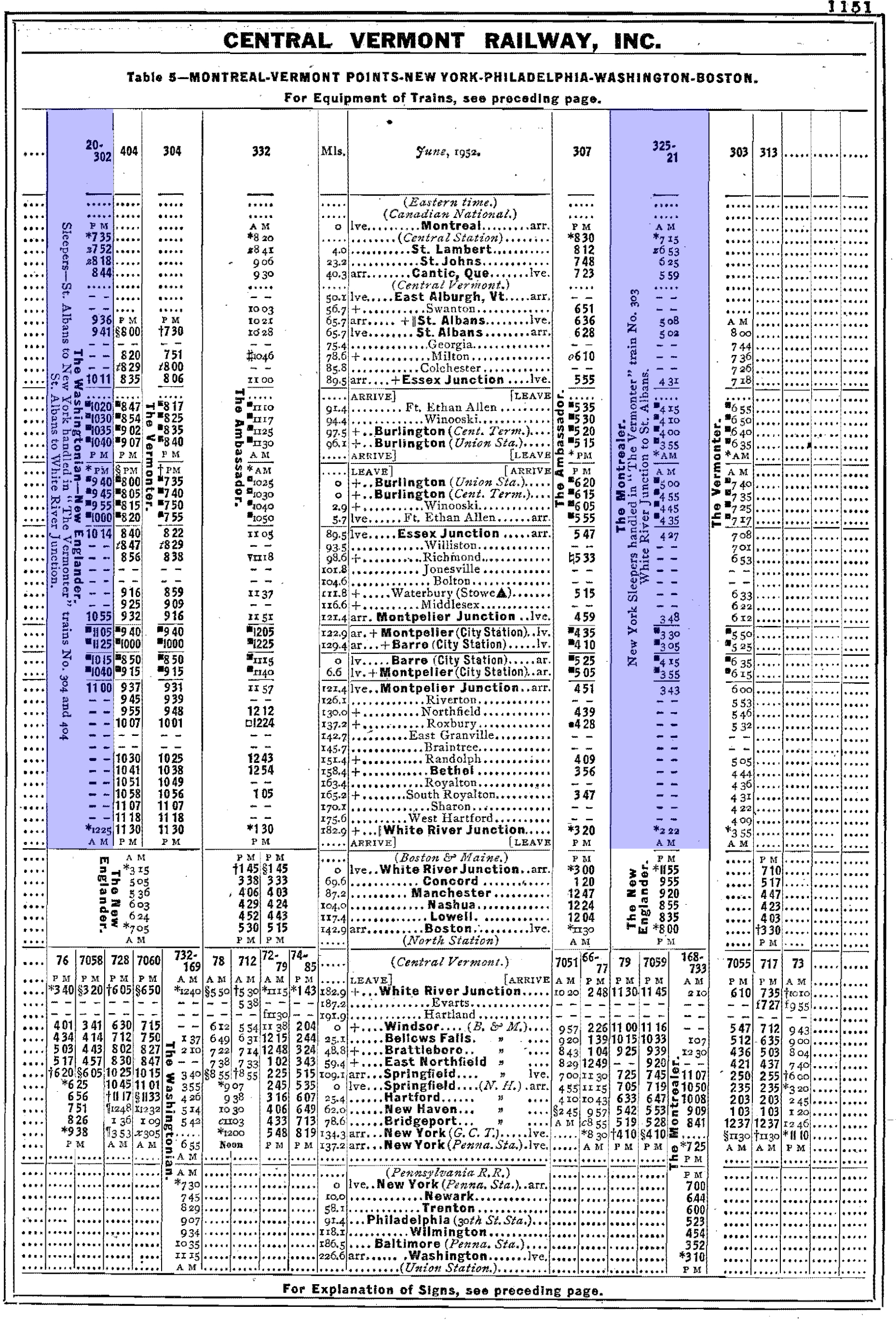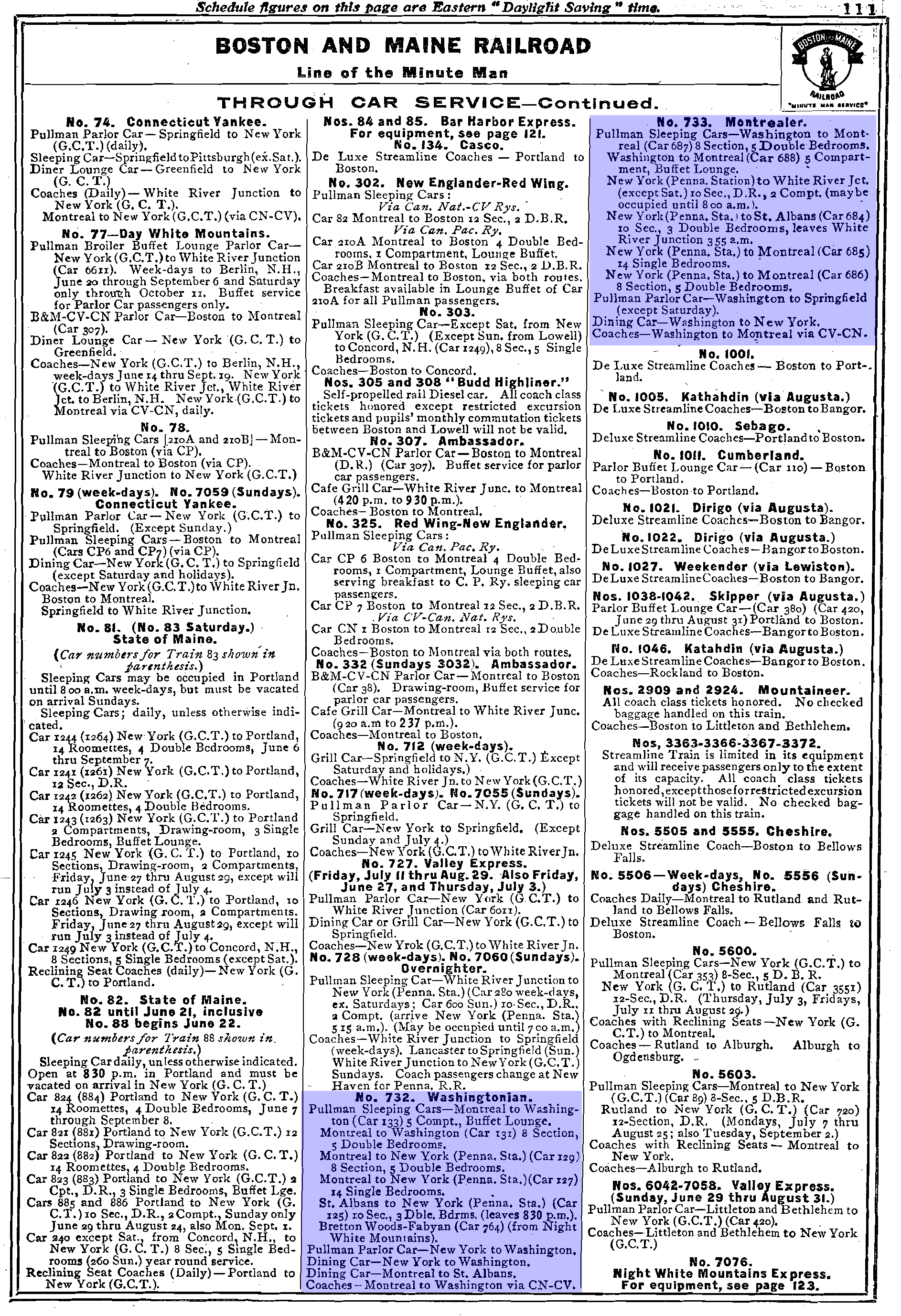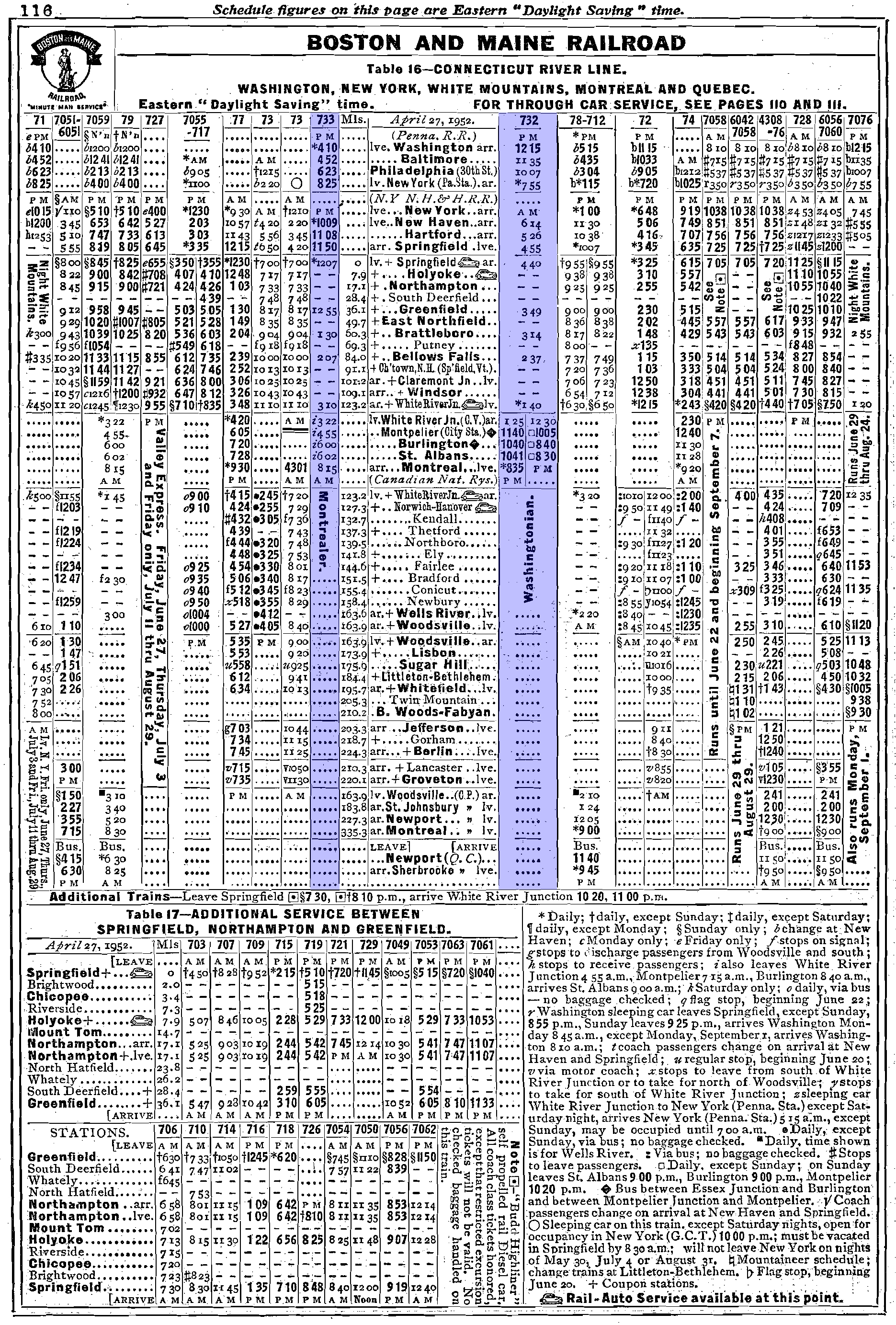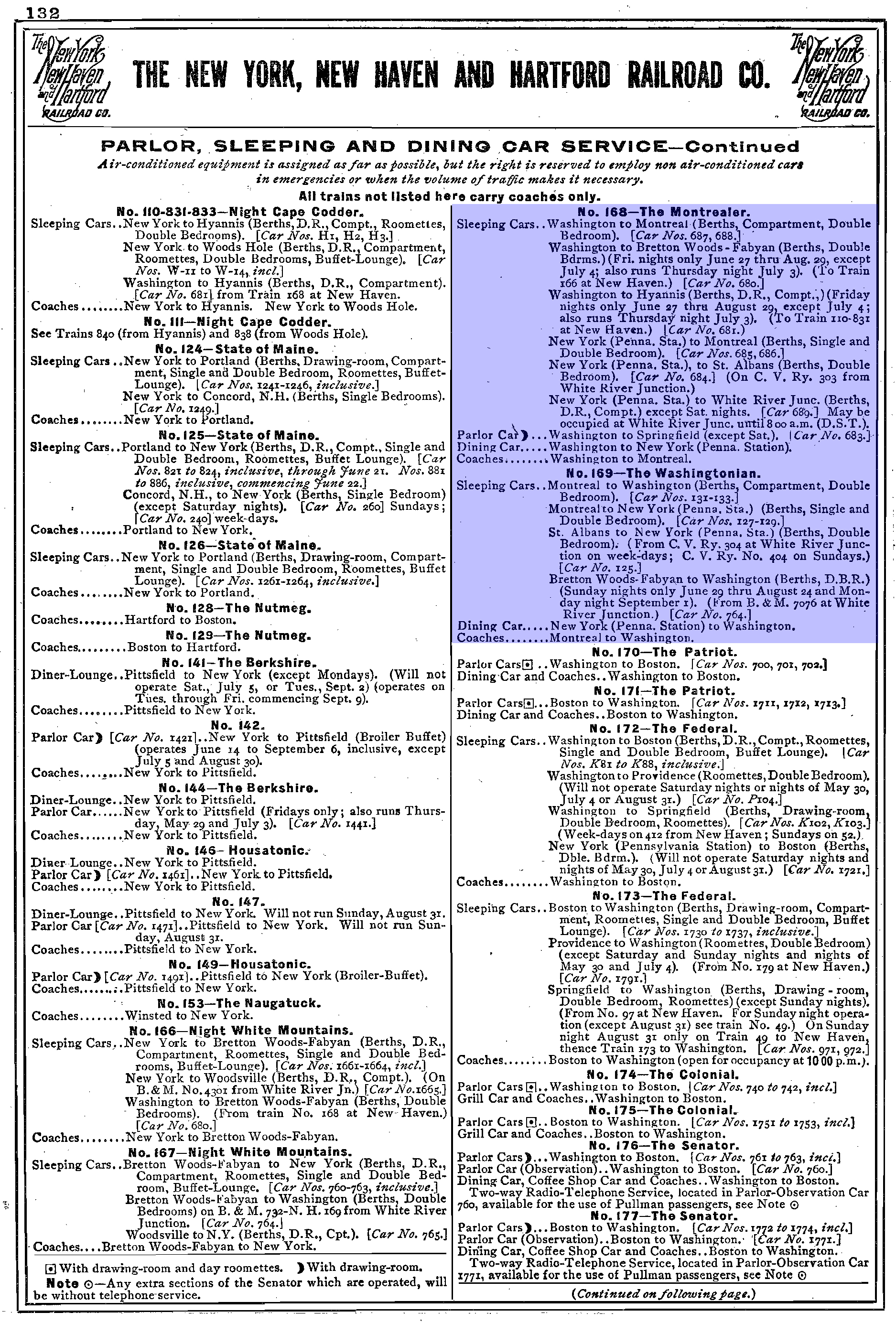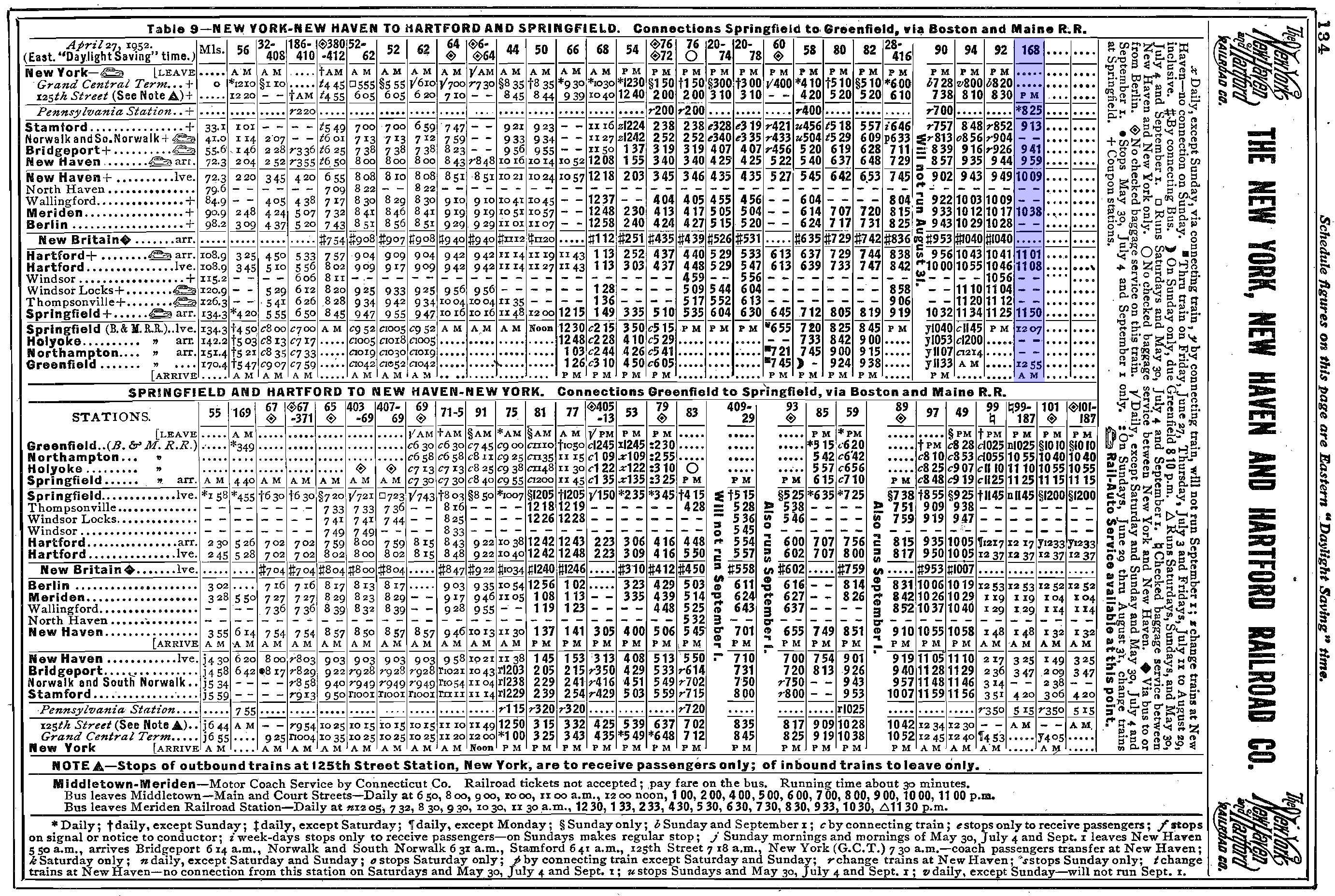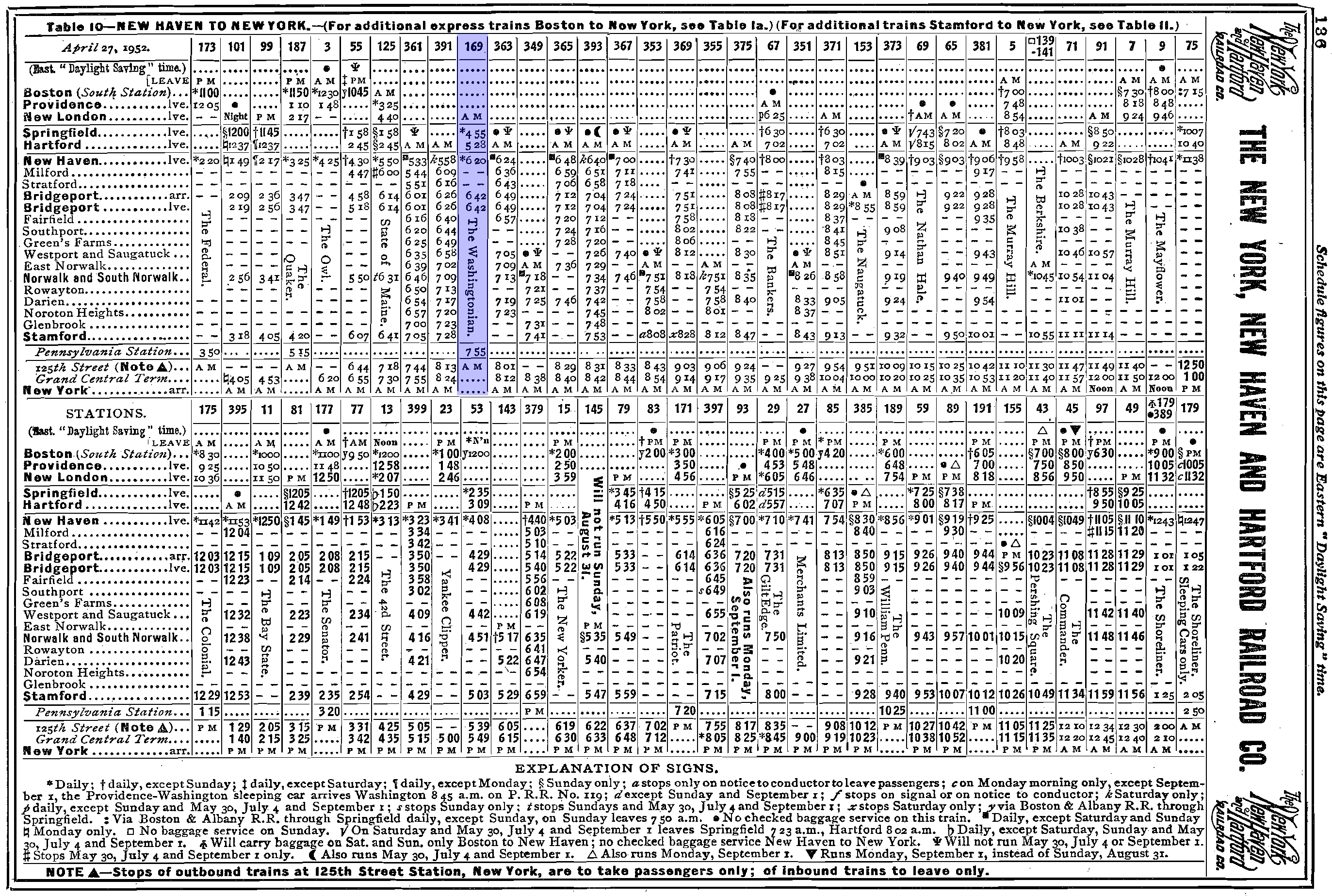Montrealer/Washingtonian (Train): Timetable, Route, Consist
Last revised: February 27, 2025
By: Adam Burns
The Montrealer/Washingtonian was the same route named for the two cities the train served; Washington, D.C. and Montreal, Quebec.
This once popular corridor required five different railroads to complete the journey which included - from north to south - the Canadian National, Central Vermont, Boston & Maine, New Haven, and Pennsylvania.
The PRR was an important component for any railroad interested in through service to the Northeast's major cities as the railroad's electrified Northeast Corridor provided efficient and high-speed service to Baltimore, Washington, Philadelphia, and New York.
Inaugurated a few years before the Great Depression the Montrealer/Washingtonian would close out long-distance international rail travel in New England when both were discontinued in the mid-1960s.
History
We, as a species, often think of ourselves as constantly progressing forward from both a societal and technological standpoint. In many ways this is certainly true while in other respects it it is not. Take, for example, our national infrastructure.
Highways and interstates now crisscross the nation - and continue to expand even as we speak - providing immense freedoms via the automobile. In addition, airlines can travel from coast-to-coast in only a few hours.
However, neither mode is truly stress free nor provides the level of relaxation afforded by rail. Yes, we have Amtrak for intercity service but this carrier offers only a fleeting glimpse of the so-called "Golden Age."
There is a reason trains are historically romanticized through stories, books, and movies; it really was a first-class, civilized way to travel.
Once upon a time on-board accommodations included things like lounge cars, Pullman sleepers, and five-star, gourmet meals freshly prepared en route. One such route offering this level of service was the Montrealer/Washingtonian.
In years past these trains not only hosted general passengers but also business clientele and U.S./Canadian diplomats traveling to their respective nation's capitals (Ottawa could be reached via a connection from the CN at Montreal).
According to Kevin Holland's book, "Passenger Trains Of Northern New England, In The Streamline Era") the train's overnight schedule enabled an early morning arrival at each destination city.
Inauguration
The Montrealer/Washingtonian was inaugurated on June 15, 1924 and originally steam-powered, carrying an all-heavyweight consist. The northbound run was known as the Montrealer while its southbound counterpart was referred to as the Washingtonian.
The following railroads handled the train; the Pennsy between Washington and New York, the New Haven from New York to Springfield (Massachusetts), Boston & Maine between Springfield and White River Junction (Vermont), Central Vermont from there to St. Albans (Vermont), and finally the Canadian National between Cantic, Quebec and Montreal.
Timetable and Consist (1952)
PRR
Central Vermont
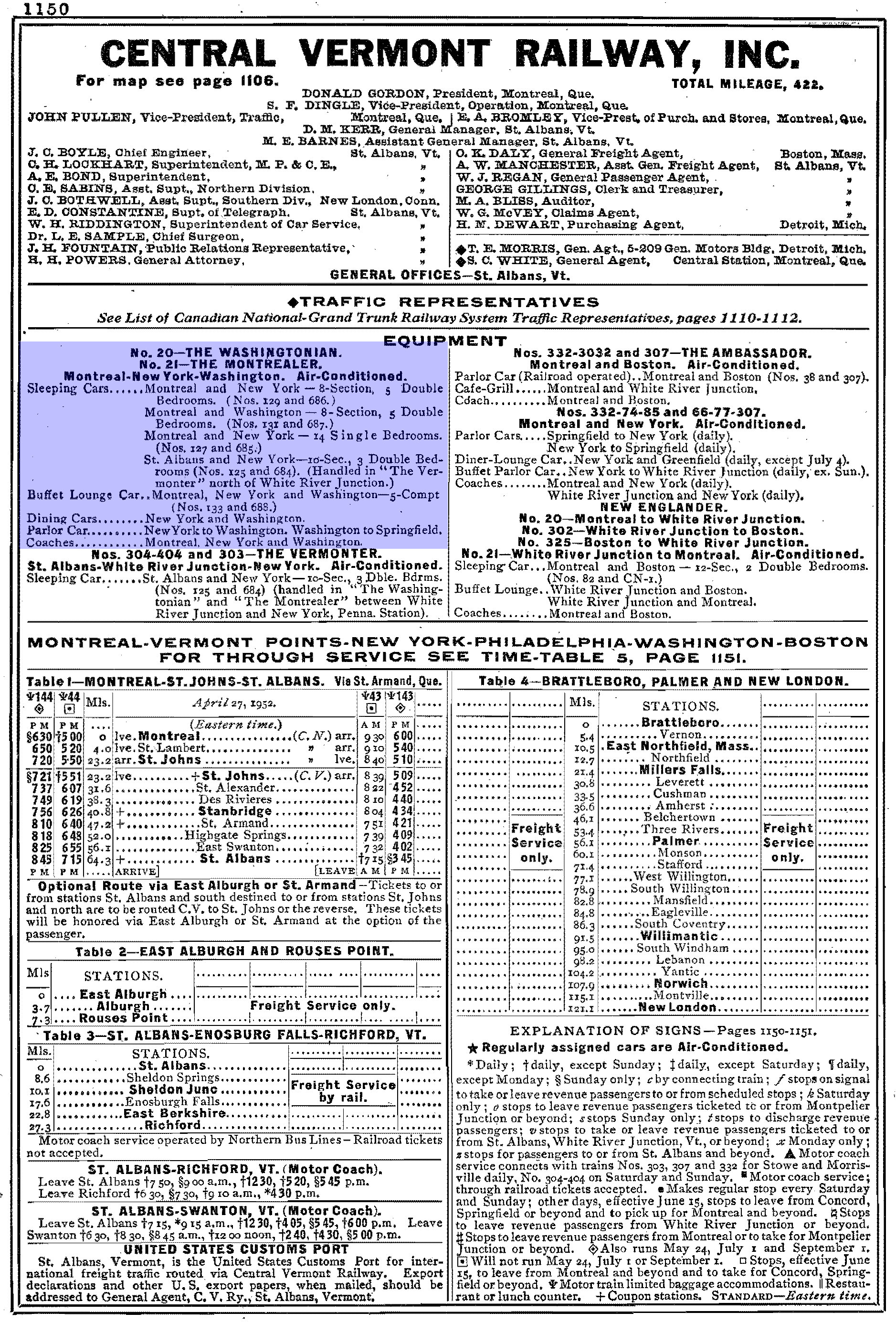
Boston & Maine
New Haven
Accommodations
The service received its first significant upgrades when, as Mike Schafer and Brian Solomon note in their book, "Pennsylvania Railroad," the PRR completed the electrification of its New York-Washington main line.
The Philadelphia-New York segment was completed in 1933 while the remaining section to Washington, D.C. opened on February 10, 1935.
A normal consist for the Montrealer/Washingtonian (although often subject to slight changes) included:
- Buffet-lounge (New York-Montreal)
- Three sleepers (6-6-4 Washington-Montreal, 6-6-4 New York-Montreal, and a 6-6-4 New York White River Junction)
- Parlor (Washington-Montreal)
- Diner (Washington-Montreal)
- Two reclining seat coaches
- Parlor-observation (New York-Washington)
While the trains were never complete streamliners they did carry lightweight sleepers after World War II, including from CN's own Green series leased to Pullman.
Timetable (August 8, 1960)
| Read Down Time/Leave (Train #152/Pennsylvania) | Milepost | Location | Read Up Time/Arrive (Train #115/Pennsylvania) |
|---|---|---|---|
| 4:00 PM (Dp) | 0.0 | 1:15 PM (Ar) | |
| 4:40 PM | 40.1 | 12:35 PM | |
| 5:39 PM | 108.5 | 11:33 AM | |
| 6:06 PM | 11:05 AM | ||
| 6:14 PM | 140.7 | 10:56 AM | |
| 168.5 | 10:29 AM | ||
| 7:20 PM | 216.6 | 9:45 AM | |
| 7:35 PM (Ar) | 226.6 | 9:30 AM (Dp) | |
| Time/Leave (Train #168/New Haven) | Milepost | Location | Time/Arrive (Train #169/New Haven) |
| 8:35 PM (Dp) | 0.0 | 8:00 AM (Ar) | |
| 9:23 PM | 36.0 | ||
| 9:51 PM | 58.5 | 6:51 AM | |
| 10:10 PM (Ar) | 75.0 | 6:30 AM (Dp) | |
| 10:25 PM (Dp) | 75.0 | 6:22 AM (Ar) | |
| 10:54 PM | 93.5 | 5:58 AM | |
| 11:07 PM | 101.0 | ||
| 11:20 PM (Ar) | 111.5 | 5:35 AM (Dp) | |
| 11:35 PM (Dp) | 111.5 | 5:31 AM (Ar) | |
| 12:15 AM (Ar) | 137.0 | 5:00 AM (Dp) | |
| Time/Leave (Train #21/Boston & Maine) | Milepost | Location | Time/Arrive (Train #20/Boston & Maine) |
| 12:40 AM (Dp) | 137.0 | 4:20 AM (Ar) | |
| 1:29 AM | 173.1 | 3:10 AM | |
| 2:12 AM | 197.3 | ||
| 2:42 AM | 221.0 | 2:12 AM | |
| 3:45 AM (Ar) | 260.2 | 1:20 AM (Dp) | |
| Time/Leave (Central Vermont) | Milepost | Location | Time/Arrive (Central Vermont) |
| 4:00 AM (Dp) | 260.2 | 1:05 AM (Ar) | |
| 5:09 AM | 313.2 | ||
| 5:20 AM (Ar) | 321.8 | 11:47 PM (Dp) | |
| 5:25 AM (Dp) | 321.8 | 11:44 PM (Ar) | |
| 5:38 AM | 331.4 | 11:32 PM | |
| 6:04 AM (Ar) | 353.6 | 11:04 PM (Dp) | |
| 6:10 AM (Dp) | 353.6 | 11:01 PM (Ar) | |
| 6:42 AM (Ar) | 377.4 | 10:31 PM (Dp) | |
| 6:51 AM (Dp) | 377.4 | 10:28 PM (Ar) | |
| Time/Leave (Canadian National) | Milepost | Location | Time/Arrive (Canadian National) |
| 402.8 | 8:44 PM (Dp) | ||
| 6:44 AM (Dp) | 402.8 | 8:43 PM (Ar) | |
| 7:08 AM | 419.5 | 8:20 PM | |
| 7:34 AM | 438.7 | 7:54 PM | |
| 7:55 AM (Ar) | 442.7 | 7:40 PM (Dp) |
Interestingly, through the 1950s Pullman equipment remained primarily heavyweight in nature while the streamlined cars often came from the four participating roads' own pool.
Considering how ridership was rapidly declining by this time, particularly in the Northeast and New England, it's somewhat amazing that sleeper/Pullman service survived as long as it did. As Mr. Holland notes the railroads were quite aware of the declining patronage and growing financial losses.
By the 1960s the B&M, CN, and New Haven began bickering over which types of sleepers should be assigned to the train's consist when, in reality, the main issue centered around participation in the Pullman deficit.
Final Years
Because of New England's susceptibility to the automobile, rail service here faded particularly quickly. As Mr. Holland points out by 1960 only the Montrealer/Washingtonian and Ambassador were still in serving in their long distance roles. In addition, they were the only trains on the B&M still carrying conventional, non-RDC (Rail Diesel Car) equipment.
Perhaps, then, it was fitting that both disappeared together making their final runs during September 3rd and 4th of 1966 despite court battles to keep all three in service; the last northbound Montrealer operated on the 3rd while the final southbound Washingtonian, carrying a five-car consist, entered history a day later on the 4th.
Sources
- Holland, Kevin J. Passenger Trains Of Northern New England, In The Streamline Era. Lynchburg: TLC Publishing, 2004.
- Lynch, Peter E. New Haven Passenger Trains. St. Paul: MBI Publishing Company, 2005.
- Murray, Tom. Canadian National Railway. St. Paul: MBI Publishing Company, 2004.
- Schafer, Mike and Solomon, Brian. Pennsylvania Railroad. Osceola: MBI Publishing, 1997.
- Stevens, G.R. History Of The Canadian National Railways. New York: The Macmillan Company, 1973.
Contents
Recent Articles
-
Rio Grande 2-8-2 Locomotives (Class K-28): Specs, Roster, Photos
Apr 14, 25 10:24 PM
Rio Grande's Class K-28 Mikados were its newest narrow-gauge steam locomotives since the Mudhens of the early 1900s. Today, three survive. -
Rio Grande K-27 "Mudhens" (2-8-2): Specs, Roster, Photos
Apr 14, 25 05:40 PM
Rio Grande's Class K-27 of 2-8-2s were more commonly referred to as Mudhens by crews. They were the first to enter service and today two survive. -
C&O 2-10-4 Locomotives: Specs, Roster, Photos
Apr 13, 25 04:07 PM
Chesapeake & Ohio's T-1s included a fleet of forty 2-10-4 "Texas Types" that the railroad used in heavy freight service. None were preserved.
